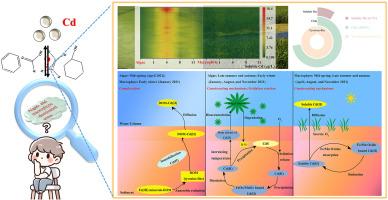Seasonal variations in cadmium mobility in sediment-water systems of algae- and macrophyte-dominated zones in Lake Taihu
IF 7.3
2区 环境科学与生态学
Q1 ENVIRONMENTAL SCIENCES
引用次数: 0
Abstract
Variations in trophic status affect water quality and sediment geochemistry, thereby influencing cadmium (Cd) mobility and its release into the water column. This study conducted seasonal sampling in algae- and macrophyte-dominated zones of Lake Taihu, China, using high-resolution dialysis and multispectral techniques to simultaneously monitor Cd, manganese (Mn), ferrous iron (Fe(II)), and dissolved organic matter (DOM) in sediment pore water. A sudden Cd release was observed in April in eutrophic, algae-dominated sediments, attributed to Cd complexation with tyrosine. Redundancy analysis (RDA) confirmed tyrosine as a key factor driving this Cd release. Multispectral analysis further showed that Cd was stably bound to functional groups in tyrosine-like substances, including aromatic C–H (630 cm−1), alcoholic C–O (1150 cm−1), phenolic O–H (1350 cm−1), alkene C=C (1630 cm−1), and aliphatic −COOH (3320 cm−1). In summer and autumn, Cd mobility in algae-dominated areas was mainly regulated by cyanobacterial uptake and redox reactions involving iron–manganese oxides. In macrophyte zones, DOM influenced soluble Cd in winter, while lower Cd levels in summer and autumn likely resulted from adsorption onto iron–manganese oxide–rich sediments, enhanced by photochemical processes and rhizosphere oxidation. Overall, Cd contamination in algae-dominated systems warrants greater attention.


太湖藻类和大型植物为主区沉积物-水体系统中镉迁移的季节变化
营养状态的变化影响水质和沉积物地球化学,从而影响镉(Cd)的流动性及其向水柱的释放。本研究在中国太湖藻类和大型植物为主的区域进行季节性采样,采用高分辨率透析和多光谱技术同时监测沉积物孔隙水中Cd、锰(Mn)、亚铁(Fe(II))和溶解有机质(DOM)。4月份在富营养化藻类为主的沉积物中观察到镉的突然释放,这是由于镉与酪氨酸络合。冗余分析(RDA)证实酪氨酸是驱动Cd释放的关键因素。多光谱分析进一步表明,Cd稳定地结合在酪氨酸类物质的官能团上,包括芳香C - h (630 cm-1)、醇性C - o (1150 cm-1)、酚性O-H (1350 cm-1)、烯烃C=C (1630 cm-1)和脂肪族- COOH (3320 cm-1)。夏季和秋季,蓝藻对Cd的吸收和铁锰氧化物的氧化还原反应主要调控了藻类主导地区Cd的迁移。在大型植物区,DOM在冬季影响可溶性Cd,而夏季和秋季较低的Cd水平可能是由于吸附在富含铁锰氧化物的沉积物上,光化学过程和根际氧化增强了Cd水平。总的来说,在藻类为主的系统中,镉污染值得更多的关注。
本文章由计算机程序翻译,如有差异,请以英文原文为准。
求助全文
约1分钟内获得全文
求助全文
来源期刊

Environmental Pollution
环境科学-环境科学
CiteScore
16.00
自引率
6.70%
发文量
2082
审稿时长
2.9 months
期刊介绍:
Environmental Pollution is an international peer-reviewed journal that publishes high-quality research papers and review articles covering all aspects of environmental pollution and its impacts on ecosystems and human health.
Subject areas include, but are not limited to:
• Sources and occurrences of pollutants that are clearly defined and measured in environmental compartments, food and food-related items, and human bodies;
• Interlinks between contaminant exposure and biological, ecological, and human health effects, including those of climate change;
• Contaminants of emerging concerns (including but not limited to antibiotic resistant microorganisms or genes, microplastics/nanoplastics, electronic wastes, light, and noise) and/or their biological, ecological, or human health effects;
• Laboratory and field studies on the remediation/mitigation of environmental pollution via new techniques and with clear links to biological, ecological, or human health effects;
• Modeling of pollution processes, patterns, or trends that is of clear environmental and/or human health interest;
• New techniques that measure and examine environmental occurrences, transport, behavior, and effects of pollutants within the environment or the laboratory, provided that they can be clearly used to address problems within regional or global environmental compartments.
 求助内容:
求助内容: 应助结果提醒方式:
应助结果提醒方式:


